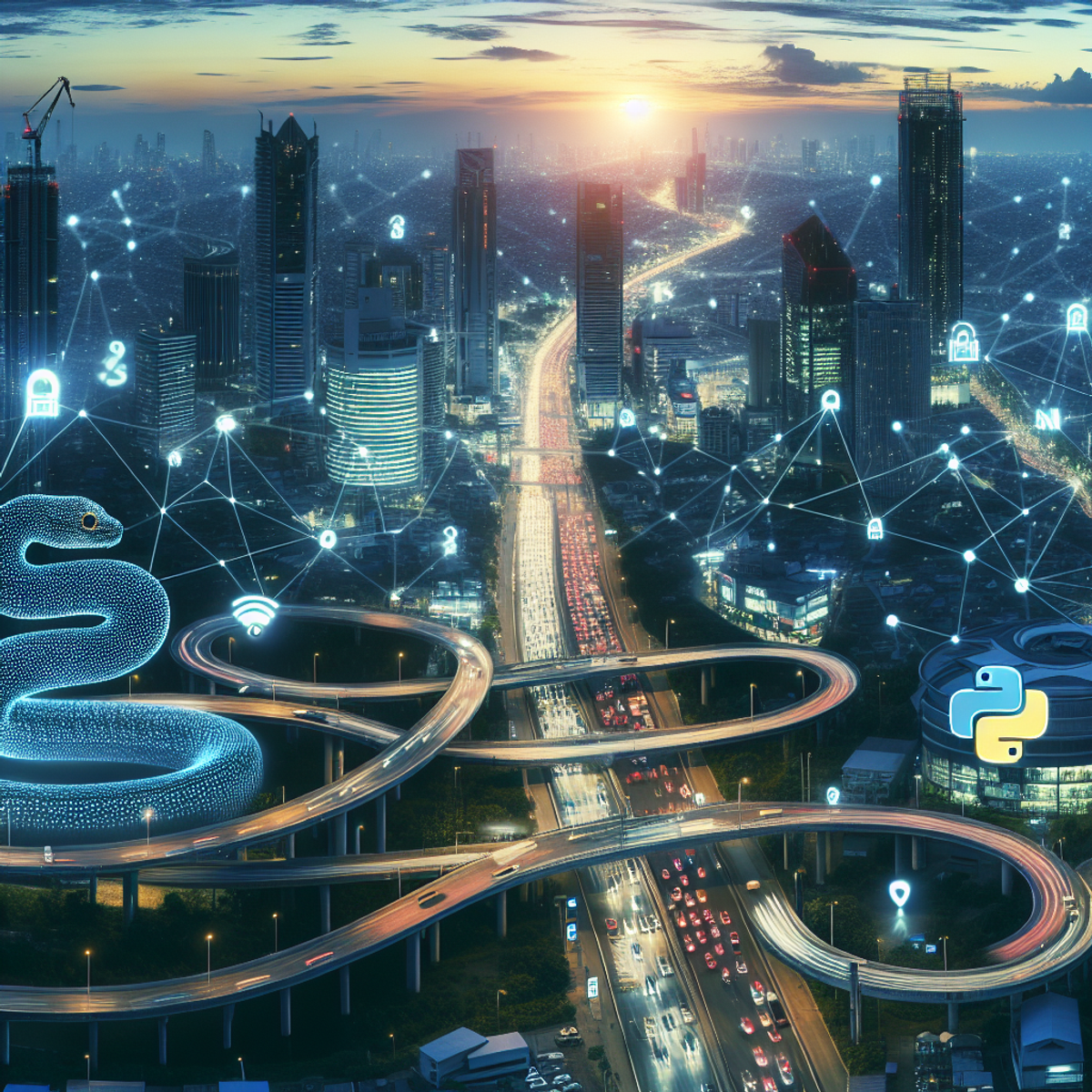Python in Intelligent Transportation Systems

Python in Intelligent Transportation Systems
Introduction
Intelligent Transportation Systems (ITS) are changing how we manage city traffic using advanced technologies to improve efficiency, safety, and sustainability. ITS combines different technologies like GSM, LPWAN, and GPS to connect devices and optimize traffic flow. Python is crucial in developing ITS as it drives innovation and enables smooth integration of hardware and software.
Python's importance in ITS development cannot be emphasized enough. It gives engineers and developers the power to create strong and flexible solutions for the complex challenges of modern transportation systems. Python's versatility and wide range of libraries make it perfect for building intelligent transportation systems that can adapt, grow, and respond quickly to real-time needs.
In this article, we will explore the main components and technologies behind ITS development. From controlling traffic signals to sharing real-time information and enabling reliable vehicle communication, Python stands out as a key player in shaping the future of intelligent transportation systems.
Let's take a closer look at how Python is driving innovation in smart cities through ITS. We'll use practical examples and insightful analysis to highlight Python's potential in transforming urban mobility and improving lives worldwide.
Components of Intelligent Transportation Systems
Intelligent Transportation Systems (ITS) rely on various technologies to connect devices and manage city traffic efficiently. In this section, we will explore the key components of ITS and highlight the role of Python in developing both hardware and software systems.
GSM, LPWAN, and GPS Technologies in ITS
- Global System for Mobile Communications (GSM): GSM technology plays a crucial role in ITS by enabling communication between vehicles and infrastructure. It allows for real-time data exchange, such as traffic information, vehicle tracking, and emergency alerts. Python can be used to develop applications that utilize GSM technology for effective communication in ITS projects. Research studies like this one provide insights into enhancing the efficiency of GSM-based communication systems.
- Low-Power Wide-Area Network (LPWAN): LPWAN technologies like LoRaWAN and NB-IoT provide long-range, low-power connectivity for IoT devices in ITS. These networks are ideal for transmitting data from sensors deployed across a wide area, allowing for efficient monitoring of traffic conditions, parking availability, and environmental factors. Python can be used to process and analyze the data collected from LPWAN-enabled devices in an ITS system. Studies such as this one delve into optimizing LPWAN usage in intelligent transportation systems.
- Global Positioning System (GPS): GPS technology is a fundamental component of ITS as it enables accurate positioning and navigation of vehicles. It allows for real-time tracking of vehicles, route optimization, and location-based services. Python can be used to develop software applications that utilize GPS data for various purposes within an ITS system. This document sheds light on the advancements in GPS technology for intelligent transportation systems.
Role of Raspberry Pi 3 in Building Hardware Systems
Raspberry Pi 3 is a popular single-board computer that has gained significant traction in the development of hardware systems for ITS. Its small form factor, low cost, and GPIO pins make it ideal for prototyping and deploying custom hardware solutions. Some examples of how Raspberry Pi 3 can be utilized in ITS include:
- Traffic signal control: Raspberry Pi 3 can be used to control traffic signals based on real-time traffic conditions or the presence of emergency vehicles. Python can be employed to develop the software that communicates with the Raspberry Pi 3 and adjusts the traffic signals accordingly.
- Data collection and analysis: Raspberry Pi 3 can be equipped with sensors to collect data on traffic volume, air quality, or road conditions. Python can then be used to process and analyze this data, providing valuable insights for traffic management and urban planning. This research paper showcases the utilization of Raspberry Pi 3 for efficient data collection in intelligent transportation systems.
Importance of Python in Developing Software Components
Python is a versatile programming language that offers numerous benefits for developing software components in ITS projects. Here are some reasons why Python is widely used in this domain:
- Readability and ease of use: Python's clean syntax and readability make it an accessible language for programming
Key Technologies for Python Development in ITS
In the field of Intelligent Transportation Systems (ITS), Python plays a crucial role in developing software components that enable efficient traffic management and communication. Let's explore some key technologies and frameworks that are relevant to Python development in ITS projects:
1. Controlling Traffic Signals with Python
Python is used extensively to control traffic signals in ITS systems. By leveraging Python's flexibility and ease of use, developers can create intelligent algorithms that optimize traffic flow and improve overall efficiency. With real-time data from sensors and cameras, Python scripts can dynamically adjust signal timings based on traffic conditions, reducing congestion and improving the movement of vehicles.
One key application of traffic signal control systems built with Python is facilitating the movement of emergency vehicles. By prioritizing their passage through intersections, these systems help emergency services reach their destinations more quickly, potentially saving lives.
2. Twilio Sync for Real-Time Information Sharing in ITS
Twilio Sync is a powerful cloud-based service that enables real-time information sharing between multiple devices connected to the internet. In the context of ITS, Twilio Sync can be used to facilitate communication between different components of an ITS system.
For example, Python scripts can utilize Twilio Sync to share real-time traffic data, such as congestion levels or accidents, with connected vehicles or mobile applications. This allows drivers to make informed decisions about their routes and helps them navigate efficiently through the city.
3. Utilizing LoRa Radio for Resilient Vehicle Communication with Python
Resilience is a critical aspect of managing emergency vehicles in Intelligent Transportation Systems. LoRa radio technology provides long-range and low-power communication capabilities, making it well-suited for vehicle-to-vehicle and vehicle-to-infrastructure communication.
Python can be used to develop software components that leverage LoRa radio technology for reliable communication between emergency vehicles and traffic management systems. By integrating LoRa radio modules with Raspberry Pi devices running Python scripts, real-time updates on the position and status of emergency vehicles can be transmitted securely, allowing for efficient management and coordination.
Building a Model ITS System with Python
To further illustrate the role of Python in ITS development, let's consider the components of a model ITS system:
- Traffic Signal Software: Python scripts can control traffic lights based on inputs from sensors, cameras, and real-time data. By dynamically adjusting signal timings, the software optimizes traffic flow and prioritizes emergency vehicles when necessary.
- GPS Device Simulation: Simulating GPS devices using Python allows for testing and development of location-based functionalities within the ITS system. This enables accurate tracking of vehicles and ensures precise coordination between different components.
- Emergency Vehicle Position Tracking: Through the integration of LoRa radio technology and Python scripts, the model system can track the position and status of emergency vehicles. Real-time updates are transmitted to traffic management systems, enabling efficient routing and coordination.
Python's Role in Advancing Smart City Applications through Intelligent Transportation Systems
Python's versatility and extensive library ecosystem make it a valuable tool for developing smart city applications within the context of ITS. By leveraging Python, developers can create scalable and robust solutions that improve transportation systems for urban populations. Some potential benefits include:
- Efficient traffic management and congestion reduction through intelligent algorithms powered by Python.
- Enhanced communication between different components of an ITS system using cloud-based services like Twilio Sync.
- Resilient vehicle communication facilitated by Python scripts utilizing technologies such as LoRa radio.
- Improved safety and response times for emergency services through prioritized traffic signal control systems.
Python's contribution to smart city applications extends beyond ITS, encompassing other areas such as energy management, waste disposal optimization, and public transportation systems. Its flexibility and ease of use make it an ideal choice for developers aiming to create innovative solutions that address the unique challenges faced by modern cities.
Python is a key technology for developing software components in Intelligent Transportation Systems. Its ability to control traffic signals, facilitate real-time information sharing, and utilize resilient communication technologies like LoRa radio make it an invaluable tool in advancing the efficiency and effectiveness of smart city applications. Developers who harness the power of Python in ITS projects can contribute to building safer, more sustainable, and more connected cities.
1. Controlling Traffic Signals with Python
Controlling traffic signals is a crucial aspect of Intelligent Transportation Systems (ITS), and Python is playing a significant role in this domain. Python provides a flexible and powerful platform for developing software solutions that can effectively manage traffic flow and ensure the smooth movement of vehicles, including emergency vehicles. Let's explore how Python is used to control traffic signals in ITS and the importance of facilitating the movement of emergency vehicles using traffic signal control systems built with Python.
How Python is used to control traffic signals in ITS
Python offers various libraries and frameworks that enable developers to build robust and efficient traffic signal control systems. Here are some ways Python is utilized in controlling traffic signals:
- Simulation and modeling: Python allows developers to simulate and model traffic patterns, enabling them to analyze different scenarios and optimize signal timings. Libraries like SUMO (Simulation of Urban MObility) provide a rich set of tools for simulating real-world traffic conditions, optimizing signal timings, and evaluating the impact on traffic flow.
- Integration with hardware: Python interfaces seamlessly with hardware components, making it easier to connect traffic signal controllers to sensors, cameras, and other devices. This allows real-time data collection and analysis, which can be used to dynamically adjust signal timings based on current traffic conditions.
- Machine learning algorithms: Python's machine learning libraries such as TensorFlow and scikit-learn can be employed to develop intelligent algorithms that learn from historical data to predict future traffic patterns. These predictions can then be used to optimize signal timings and minimize congestion.
Importance of facilitating the movement of emergency vehicles using Python-based traffic signal control systems
Emergency vehicles play a critical role in saving lives during urgent situations. However, their ability to reach their destinations quickly can often be hindered by heavy traffic congestion. Python-based traffic signal control systems can significantly enhance the movement of emergency vehicles by:
- Priority signaling: Python allows traffic signal control systems to prioritize emergency vehicles by giving them preferential treatment at intersections. When an emergency vehicle is detected, the system can adjust signal timings in real-time to clear the path, ensuring a smooth and swift passage.
- Dynamic rerouting: Python-based systems can dynamically reroute traffic to create dedicated lanes for emergency vehicles. By analyzing real-time traffic data and adjusting signal timings accordingly, these systems can create temporary paths that allow emergency vehicles to bypass congested areas and reach their destinations faster.
- Integration with GPS technology: Python's integration with GPS technology enables traffic signal control systems to receive real-time updates on the position and movement of emergency vehicles. This information can be used to optimize signal timings and ensure that intersections are clear when an emergency vehicle is approaching.
By leveraging Python's capabilities in controlling traffic signals, ITS can effectively facilitate the movement of emergency vehicles, potentially saving valuable time and lives.
2. Twilio Sync for Real-Time Information Sharing in ITS
Intelligent Transportation Systems (ITS) rely on real-time information sharing to effectively manage city traffic and emergency vehicles. One key technology that plays a crucial role in enabling this real-time communication is Twilio Sync, a cloud-based service designed for seamless data synchronization and sharing across multiple devices connected to the internet within an ITS ecosystem.
Introduction to Twilio Sync
Twilio Sync serves as a powerful tool for enabling real-time information exchange in ITS. It provides developers with the capability to synchronize and share data in real time, allowing various components of an ITS system to communicate and coordinate seamlessly. By leveraging Twilio Sync, developers can establish a robust infrastructure for disseminating critical information across different devices within the transportation network.
Enhancing Communication in ITS
Twilio Sync enriches the communication infrastructure in ITS by facilitating instant data updates and ensuring that all relevant devices within the system are consistently aligned with the latest information. This capability is particularly valuable in scenarios where dynamic changes, such as traffic updates or emergency vehicle movements, need to be communicated swiftly and accurately across the entire network.
Twilio Sync's real-time synchronization features enable a high degree of responsiveness, which is essential for maintaining situational awareness and making well-informed decisions within an intelligent transportation framework. By providing a unified platform for seamless data sharing, Twilio Sync contributes significantly to the efficiency and reliability of communication between different components of an ITS system.
In summary, Twilio Sync plays a pivotal role in ensuring that real-time information sharing is seamlessly integrated into Intelligent Transportation Systems, thereby enhancing their overall effectiveness in managing city traffic and emergency vehicle operations.
Using LoRa Radio for Reliable Vehicle Communication with Python
LoRa (Long Range) radio technology is a wireless communication protocol that enables long-range, low-power communication between devices. In Intelligent Transportation Systems (ITS), LoRa radio-based communication is crucial for managing emergency vehicles and facilitating effective vehicle-to-vehicle communication. Python, known for its versatility and user-friendly nature, is often used alongside LoRa radio technology to create robust vehicle communication systems. In this article, we will explore how LoRa radio and Python contribute to the management of emergency vehicles in ITS.
Understanding LoRa Radio-based Communication in ITS Systems for Managing Emergency Vehicles
LoRa radio technology offers a dependable and long-distance communication solution for handling emergency vehicles within an ITS system. By utilizing low-power, wide-area network (LPWAN) capabilities, LoRa facilitates efficient and secure communication between various components involved in managing emergency response scenarios. Here's how LoRa radio-based communication works:
- LoRaWAN Network: A LoRaWAN network acts as the main infrastructure for connecting devices and gateways. It allows devices to communicate bidirectionally with applications, ensuring smooth connectivity across an entire city or region.
- LoRa Devices: Emergency vehicles are equipped with LoRa-enabled devices that send and receive data over the LoRaWAN network. These devices can communicate with other vehicles, traffic management systems, control centers, and other relevant components.
- Gateways: Gateways serve as intermediaries between LoRa devices and the backend infrastructure. They receive data from nearby devices and transmit it to the appropriate application servers through the LoRaWAN network.
- Application Servers: Application servers process the data received from gateways and take necessary actions based on predefined rules. For emergency vehicles, this may involve updating traffic signal timings, redirecting vehicles to avoid congestion, or providing real-time information to control centers.
By utilizing LoRa radio-based communication, the management of emergency vehicles becomes more efficient and responsive. Real-time data exchange enables quick decision-making and enhances the overall effectiveness of emergency response systems.
The Significance of Reliability in Ensuring Effective Management of Emergency Vehicles Using LoRa Radio Technology
Reliability is a crucial aspect of ITS systems, especially when it comes to managing emergency vehicles. In emergency situations, the ability to maintain stable communication channels becomes essential for ensuring efficient coordination and response. Here's why reliability is crucial in utilizing LoRa radio technology for managing emergency vehicles:
- Strong Communication: LoRa radio technology provides long-range communication capabilities even in challenging environments where traditional cellular networks may be unavailable or congested. This ensures that emergency vehicles can communicate effectively regardless of their location or network conditions.
- Backup Options: Reliable vehicle communication relies on having alternative communication paths to minimize the risk of single points of failure. By using multiple gateways and LoRa devices, the system can maintain connectivity even if one component fails or faces interference.
- Efficient Power Usage: Emergency vehicles need to conserve power to ensure uninterrupted operation during critical situations. LoRa radio technology offers low power consumption, allowing devices to function for extended periods without frequent battery replacements or recharges.
- Protected Communication: Dependable vehicle communication systems must prioritize data security to prevent unauthorized access or tampering. LoRa radio technology incorporates robust encryption mechanisms, ensuring secure transmission of sensitive information related to emergency operations.
By integrating Python into the development process, developers can leverage its extensive libraries and frameworks to further enhance the reliability of vehicle communication systems. Python's flexibility enables seamless integration with other components and protocols used in ITS, making it an ideal choice for building sturdy solutions.
LoRa radio-based communication, combined with Python development, plays a vital role in managing emergency vehicles within Intelligent Transportation Systems. It provides long-range, low-power communication capabilities and ensures reliability in challenging environments, enabling effective coordination and response during emergency situations.
Building a Model ITS System with Python
To understand how Python is used in Intelligent Transportation Systems (ITS), let's take a look at the process of building a model ITS system. This will give us an idea of how Python fits into the picture and what it can do. In this section, we'll cover the following topics:
- Overview of Building a Model ITS System with Python
- The Role of Traffic Signal Software
- GPS Device Simulation
- Emergency Vehicle Position Tracking
Overview of Building a Model ITS System with Python
Building a model ITS system involves putting together different hardware and software parts to create a working system that can handle traffic efficiently and ensure smooth vehicle movement, including emergency vehicles. Python is an essential tool for developing the software side of this system.
The Role of Traffic Signal Software
Traffic signal software is an important component of an ITS system as it controls when traffic lights turn on and off at intersections. With Python, developers can write code that adjusts traffic light timings based on current traffic conditions and priorities such as the presence of emergency vehicles.
Python's flexibility allows for the implementation of complex algorithms that can adapt traffic light patterns in real-time to optimize traffic flow. By taking into account factors like traffic congestion, pedestrian crossings, and emergency vehicle routes, Python-powered traffic signal software can greatly improve overall traffic management.
GPS Device Simulation
GPS device simulation is another key part of a model ITS system. It involves imitating GPS devices to provide accurate location information for vehicles within the system. Python provides libraries and tools that make it easy for developers to simulate GPS devices effectively.
By using Python to simulate GPS devices, developers can generate realistic location data for testing purposes. This allows them to see how the ITS system reacts to different vehicle positions and movements in various scenarios. Precise GPS device simulation enhances the dependability and effectiveness of the entire system.
Emergency Vehicle Position Tracking
Efficient handling of emergency vehicles is critical in an ITS system. Python makes it possible to track the positions of these vehicles in real-time by using live data from GPS devices installed in them. By constantly monitoring where they are, the system can make smart choices to optimize traffic lights and ensure that emergency vehicles reach their destinations quickly and safely.
Using Python's advanced capabilities for working with data, developers can analyze the position data of emergency vehicles as it comes in. This allows them to dynamically adjust traffic light timings to give priority to these vehicles. By incorporating emergency vehicle position tracking into the model ITS system, Python significantly improves the overall efficiency of emergency response.
In summary, building a model ITS system with Python involves putting together different hardware and software parts. Traffic signal software, GPS device simulation, and emergency vehicle position tracking are all important pieces of this puzzle. With its flexibility and power, Python enables developers to create sophisticated algorithms that optimize traffic flow, simulate realistic GPS device behavior, and track emergency vehicle positions effectively. By making use of what Python has to offer, developers can build ITS systems that enhance traffic management and improve emergency response in our cities.
Python's Role in Advancing Smart City Applications through Intelligent Transportation Systems
Smart city applications are essential for urban development, aiming to improve residents' quality of life by integrating technology into city infrastructure. One area where Python plays a significant role in advancing smart city applications is through Intelligent Transportation Systems (ITS). Python's versatility and extensive range of libraries make it an ideal choice for developing software components that enhance transportation systems and contribute to the overall development of smart cities.
How Python contributes to the development of smart city applications in the context of ITS
Python offers several advantages that contribute to the development of smart city applications within the realm of ITS:
- Ease of use and readability: Python's simple syntax and readability make it accessible even to those without extensive programming experience. This characteristic allows developers to quickly understand and modify existing code, making it easier to collaborate on complex projects.
- Rapid prototyping and development: Python's extensive collection of libraries and frameworks, such as Flask and Django, streamline the process of building software components for ITS systems. These tools provide pre-built functionality that can be easily integrated into projects, reducing development time and effort.
- Data analysis and machine learning capabilities: Python has become a popular language for data analysis and machine learning due to libraries like NumPy, Pandas, and scikit-learn. These libraries enable developers to analyze traffic data, predict congestion patterns, optimize traffic signal timings, and develop intelligent routing algorithms.
- Integration with hardware components: Python's compatibility with hardware devices makes it a versatile choice for developing software that interacts with sensors, cameras, and other IoT devices used in ITS systems. This capability allows for seamless integration between hardware and software components, enabling efficient data collection and real-time decision-making.
Potential benefits of using Python in improving transportation systems for urban populations
By leveraging Python's capabilities within ITS systems, cities can unlock a range of benefits that directly impact urban populations:
- Efficient traffic management: Python's ability to analyze and process large amounts of traffic data facilitates effective traffic management. By utilizing machine learning algorithms, cities can optimize traffic signal timings, identify congestion hotspots, and implement dynamic traffic control systems that respond to real-time conditions. This results in reduced travel times, improved traffic flow, and enhanced overall transportation efficiency.
- Enhanced public transportation: Python can be used to develop software components that improve the operations of public transportation systems. By integrating real-time data from buses, trains, and other modes of transport, cities can provide accurate arrival time predictions, optimize routes, and enable seamless multimodal journeys for commuters. This enhances the reliability and convenience of public transportation, encouraging its use as a sustainable alternative to private vehicles.
- Improved safety and emergency response: Intelligent Transportation Systems powered by Python can significantly enhance safety measures within cities. Real-time monitoring of traffic patterns allows for proactive identification of hazardous areas or potential accidents. Additionally, Python-based systems can facilitate the smooth movement of emergency vehicles by adjusting traffic signals dynamically based on their positions or by providing optimal routing information during emergencies.
- Sustainable urban mobility: Python's data analysis capabilities empower cities to develop sustainable transportation solutions that reduce carbon emissions and promote clean energy alternatives. By analyzing data collected from various sources, such as vehicle sensors and weather stations, Python-based systems can optimize energy consumption, encourage the use of electric vehicles, and support the integration of renewable energy sources into transportation infrastructure.
Python's role in advancing smart city applications through Intelligent Transportation Systems is multi-faceted. Its ease of use, extensive libraries, and data analysis capabilities make it an invaluable tool for developing software components that optimize traffic management, enhance public transportation systems, improve safety measures, and promote sustainable urban mobility. As cities continue to evolve towards smarter and more connected environments, Python will continue to play a vital role in shaping the future of transportation and urban development.
Conclusion
Python's versatility and adaptability make it a powerful tool for driving innovation in Intelligent Transportation Systems (ITS). By leveraging Python, developers can create efficient and scalable solutions that address the complexities of modern urban transportation. The dynamic nature of Python opens up a world of possibilities for enhancing ITS projects and contributing to the development of smart city applications.
As you delve into the realm of ITS, consider the myriad ways Python can elevate your projects:
- Flexible Development: Python's intuitive syntax and extensive libraries empower developers to build robust and adaptable ITS solutions. Whether it's traffic signal control systems or real-time information sharing, Python facilitates seamless development across various components of an ITS architecture.
- Cross-Platform Compatibility: With Python, you can ensure compatibility across different hardware and software systems within an ITS environment. This cross-platform functionality streamlines integration and enhances interoperability, paving the way for comprehensive and cohesive transportation solutions.
- Rapid Prototyping: Python's rapid prototyping capabilities enable swift iteration and testing of ITS applications. This agility is invaluable for refining functionalities, optimizing performance, and responding to evolving urban infrastructure needs effectively.
- Machine Learning and Data Analytics: Python's rich ecosystem for machine learning and data analytics empowers ITS developers to harness the power of data-driven insights. From predictive traffic modeling to intelligent routing algorithms, Python's data-centric capabilities drive innovation in traffic management and urban mobility optimization.
As you venture into the realm of smart city applications and urban mobility, consider how Python can unlock new frontiers:
- Scalable Solutions: Python's scalability allows for the development of scalable solutions that can evolve with the dynamic demands of smart urban environments. From adaptive traffic control to intelligent parking management, Python enables the creation of agile solutions that cater to evolving urban mobility challenges.
- Interconnected Systems: By harnessing Python's prowess, you can seamlessly integrate various components of smart city applications with ITS frameworks. This interconnectedness fosters holistic urban mobility ecosystems that prioritize efficiency, sustainability, and user-centric experiences.
- Community Collaboration: Embracing Python in ITS development encourages collaboration within the developer community. Open-source libraries and frameworks foster a culture of knowledge sharing and collective innovation, propelling smart city initiatives towards greater inclusivity and accessibility.
In conclusion, as you embark on your journey to explore the intersection of Python and Intelligent Transportation Systems, envision a future where innovative technologies converge to redefine urban mobility. Embrace the boundless potential of Python as a catalyst for advancing smart city applications through innovative approaches to transportation systems. Let your curiosity guide you as you navigate through the diverse opportunities offered by Python in shaping the future landscape of Intelligent Transportation Systems.
FAQs (Frequently Asked Questions)
What is the importance of Python in Intelligent Transportation Systems (ITS) development?
Python plays a crucial role in ITS development by providing a versatile and efficient programming language for building software components, controlling hardware systems, and facilitating real-time information sharing in ITS projects.
What are the key components of Intelligent Transportation Systems (ITS) that Python is associated with?
Python is associated with technologies such as GSM, LPWAN, GPS, and Raspberry Pi 3. It is used for developing software components, controlling hardware systems, and enabling real-time communication in ITS projects.
How is Python utilized in controlling traffic signals within Intelligent Transportation Systems (ITS)?
Python is used to control traffic signals by facilitating the movement of emergency vehicles and optimizing traffic flow. It enables the development of intelligent systems that respond dynamically to changing traffic conditions.
What role does Twilio Sync play in real-time information sharing within Intelligent Transportation Systems (ITS), and how does it relate to Python?
Twilio Sync serves as a cloud-based service for real-time information sharing in ITS. Python enhances communication between multiple devices connected to the internet within an ITS system, enabling seamless data exchange through Twilio Sync.
How does Python contribute to the advancement of smart city applications through Intelligent Transportation Systems (ITS)?
Python contributes to the development of smart city applications by improving transportation systems for urban populations. It enables the creation of efficient and innovative solutions that address the complex challenges of urban mobility.
What are some key technologies/frameworks relevant to Python development in Intelligent Transportation Systems (ITS) projects?
The key technologies/frameworks relevant to Python development in ITS projects include traffic signals, emergency vehicles, Twilio Sync, cloud-based services, LoRa radio, and resilience. These technologies play a crucial role in enhancing the functionality and effectiveness of Python-based ITS solutions.

Comments
Post a Comment